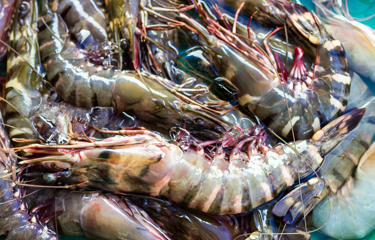India, the world’s top exporter of whiteleg shrimp (Litopenaeus vannamei), is exploring a return to growing more black tiger shrimp (Penaeus monodon) as a means of diversifying its offerings.
India’s shrimp farmers used to farm black tiger shrimp extensively, especially in the country’s coastal regions. But issues with diseases affecting black tiger shrimp production discouraged investment in the sector, and when whiteleg shrimp was introduced to India in 2009, it took just a few years for Indian farmers and investors to complete an almost wholesale shift over to vannamei, which they preferred due to its higher productivity and better disease resilience. India’s black tiger shrimp production fell to 38,000 metric tons (MT) in financial year 2019-2020, down from more than 100,000 MT of production achieved regularly between 2010 and 2013, according to data from India’s Marine Products Exports Development Authority (MPEDA).
With the shift, India found a willing market in the United States, and for the past five years, India has been the top exporter of shrimp to the U.S.A. India increased its market share in the United States up to a high of 40.5 percent in 2019, but India’s shrimp sector had a difficult year in 2020, with production and export performance severely hit by the COVID-19 pandemic. The South Asia nation is estimated to have produced between 650,000 and 700,000 metric tons (MT) of shrimp last year, down from 780,000 to 800,000 MT in 2019. It remained the top shrimp exporter to the U.S., but its U.S. exports actually shrank in 2020 from 632.5 million pounds, or 286,902 metric tons (MT), in 2019; to 599.3 million pounds (271,831 MT) last year. And 2021 has been even worse for India as it experienced one of the worst outbreaks of COVID-19 globally, causing serious harm to its shrimp industry.
As a result of all of these factors, India is likely to focus more on farming of black tiger shrimp, according to shrimp industry analyst Willem van der Pijl.
Van der Pijl founded the Seafood Trade Intelligence Portal (STIP) in 2013 and formed shrimp industry consultancy Shrimp Insights in June 2020. In his most recent analysis, van der Pijl said vannamei cultivation is becoming less profitable in India due both to falling prices and mounting disease issues, and many Indian vannamei farmers are no longer earning profits from their businesses.
“Their margins are being squeezed, and even with a successful crop, farmers struggle to make a profit,” van der Pijl said.
As a result, some farmers have already returned to farming black tiger shrimp. But most farmers in India remain reluctant to make the switch due to the unavailability of specific pathogen-free (SPF) black tiger broodstock, according to van der Pijl.
To address the supply issues of SPF broodstock, the Indian government in October 2019 granted permission for Moana Technologies from Hawaii and Aquaculture de la Mahajambre (known as Aqualma) from Madagascar to supply SPF black tiger broodstock to India. Currently these are the only two suppliers of SPF black tiger broodstock in India through their two Indian partner hatcheries –Vaishnavi Aquatech, the partner of Moana; and Unibio, the partner of Aqualma. The first 2,000 broodstock from the two suppliers were delivered to India by the end of last year. In total, Vaishnavi Aquatech and Unibio have sold 125 to 135 million post-larvae to local farmers since the start of this year. Vaishnavi Aquatech expects to increase its production in Andhra Pradesh to 200 million post-larvae by June, from current 125 million post-larvae, with a plan to open two more hatcheries in 2022. Aquatech hopes to produce 30,000 broodstock in 2022, and the company hopes to deliver 52,000 broodstock by 2026. Vaishnavi Aquatech also runs shrimp farms on an area of 300 hectares in Gujarat expected to have a collective output of 1,000 MT of black tiger shrimp this year. The other hatchery, operated by Unibio, has a predicted output of 10 million post-larvae, though complications caused by the COVID-19 crisis in India may depress that total.
According to van der Pijl, Europe, Japan, and China will likely emerge as willing buyers of India’s increased black tiger shrimp production.
“Four of my contacts at major shrimp buyers in Northwestern Europe argue that they would gladly see India step up and produce more black tiger shrimp,” he said. “If India can once again produce dark uniform color products, my contacts would be happy to talk with their suppliers to start buying black tiger shrimp in India once again.”
These European buyers, however, warned that Indian shrimp vendors should set a reasonable pricing for their black tiger shrimp, van der Pjil said, with an eye on Bangladesh, which sells its shrimp at zero duty in the European Union, to determine their own pricing. At present, black tiger shrimp production from Bangladesh is in decline, while black tiger shrimp produced in Vietnam is considered too expensive for most markets in Europe, van der Pijl said.
Japan, which imports about 40 percent of India’s black tiger shrimp production, last year lifted inspection on black tiger shrimp from India after residue of the synthetic antibacterial drug furazolidone was no longer detected in any Indian cargoes.
The other potential market for India’s black tiger shrimp is China, which is already a major buyer of black tiger shrimp from Vietnam. China is also considered by CP Foods Executive Vice President Robins McIntosh to be the largest market for the company’s black tiger broodstock, according to van der Pijl.
“Therefore, I do believe that if branded and marketed the right way, Chinese buyers may be willing to pay the price that India’s farmers are hoping to make the switch back to black [tiger shrimp] worthwhile,” van der Pijl said.
Photo courtesy of Kentaro Foto/Shutterstock







